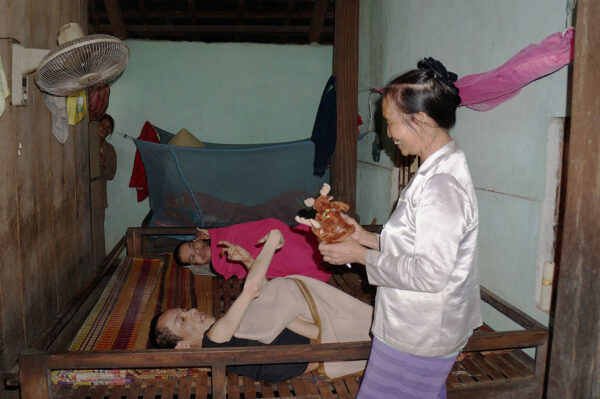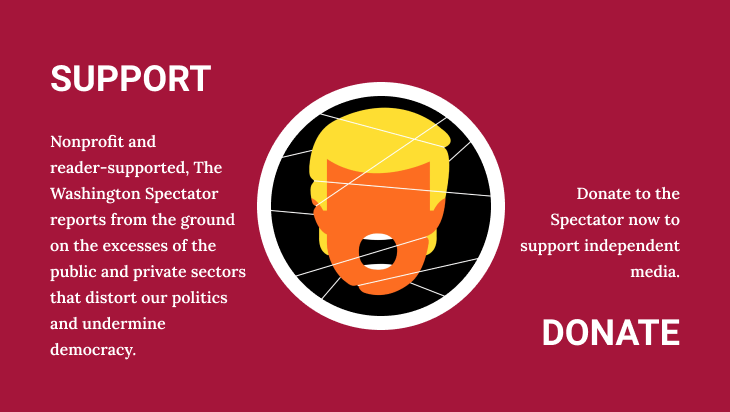The end of February in Vietnam is the beginning of the hot and muggy season. The humidity shimmers under the sun, and the air is so dense it’s hard to breathe. It was on such a day in February 2013, in Quảng Nam Province, in central Vietnam, that our small delegation walked along the berm of a rice paddy and crossed a narrow wooden plank laid over an irrigation canal to reach a modest home surrounded by jackfruit and palm trees. Sunlight shone through cracks in the roof where rain likely poured through during storms.
We were with our colleague from the Quảng Nam Red Cross, who introduced us to Mrs. Xuan and her husband, Vo, a former soldier of the Army of the Republic of Vietnam. They had five children. One had died. One was married. Another son, who still lived with them, had developmental disabilities. And then there were the twins, Anh and Em, born in 1982, who had never walked, never spoken, and had been bedridden, suffering from seizures, for all of their lives.
Mrs. Xuan explained to us what her daily routine consisted of: hours of laborious caretaking. She wakes up early to prepare and hand-feed her sons their breakfast, a process that takes nearly two hours. Then comes her bathing them and the cleaning of the rattan bed they sleep on and the ground below they use as their toilet. Lunch requires another hour. Between meals, she turns their bodies to prevent sores and offers sips of water to prevent dehydration. The next round of bathing, feeding, and cleaning begins all over again in the evening and into the night.
This was the reality of life for Mrs. Xuan for more than three decades—33 years of caregiving around the clock. The haunting moans of the twin sons, Anh and Em, lying on their rattan bed, echoed through the wooden walls of their house; it was because of this, their sons’ erratic health, that Mrs. Xuan never worked in the rice fields, never visited the market. She rarely left their side.

Mrs. Xuan, Anh and Em, photo by author.
Vo alone tended to their rice crop, upon which their entire family depended, without any savings for emergencies, without guarantees for the near future. There were times when their rice supply would not make it through the next harvest. Vo explained to us their situation; he implored us to ask the U.S. government to do something to help him and other families like his.
That day was the hardest of our trip for our delegation. Perhaps it was because of the cumulation of all the many similar stories and conditions of life we witnessed—the faces, the quiet desperation, the maladies and infirmities so many lived with, and the dignity of loving parents caring for loved ones—and the weight of crushing odds against them. Nancy Feldman and her daughter, Sara, had visited dozens of such families on this, their first trip to Vietnam. These families had received modest support from the Bob Feldman Fund, a program administered by the War Legacies Project, or WLP, to assist families with children believed to be affected by Agent Orange.
The fund offered small grants for families, particularly for caregiving parents like Vo and Mrs. Xuan, to start small home-based businesses, repair leaky roofs or rebuild a house, purchase livestock to breed (usually cows or pigs), or financially support the education of another child. But it was, we knew, a drop in the bucket. It wasn’t always enough. What haunted us most were the questions that lay beyond daily survival: who would care for these children after their parents were gone? Addressing the full impact of Agent Orange in Vietnam required much greater resources than our small organization could provide.
The Bob Feldman Fund was created in 2006, before Bob died of lymphoma, a cancer linked to Agent Orange exposure during his service in Biên Hòa. He and Nancy, his wife, wanted some portion of his Veteran Affairs benefits to go to Vietnamese families affected by the same chemicals; and since his passing, Nancy has continued donating her widow’s benefits to the fund. Over the years, many others—friends, family, strangers moved by Bob and Nancy’s story—have contributed to the fund. As of 2024, the fund has raised nearly $550,000 and supported 640 families. Many recipients in Vietnam tell us that what matters most is not the money but the sense of shared history: that the help came from others in the United States who also suffered from Agent Orange.
My own father died from Parkinson’s disease related to his service in Vietnam, and so, for me, this work of managing the fund has been so meaningful and personal. I feel honored, after all these years, that Nancy entrusted me and WLP to ensure the fund reaches families in need in Vietnam.
When we met Vo and his family in 2013, the United States had only just begun allocating funds for “health and disability activities in areas that were targeted with Agent Orange.” But none of the funding was reaching rural Nông Sơn district, where Mr. Vo’s family lived. Far less money was being appropriated for programs that assisted people with such severe conditions as Anh and Em, for whom medical intervention and care or rehabilitation were deemed too little too late. U.S. assistance in those years focused primarily on expanding physical therapy services in urban centers like Đà Nẵng. There was no mechanism for direct home care. Families unable to carry their children across rice paddies to distant clinics were, in effect, left out.
When I began advocating for U.S. accountability over Agent Orange human health consequences back in the late 1990s, research by Hatfield Consultants and their Vietnamese colleagues had determined that there was no longer any residual danger of dioxin exposure in the areas where Agent Orange was sprayed. But areas where Agent Orange and the other color-coded herbicides had been stored and loaded onto planes, such as Biên Hòa and Đà Nẵng, were still heavily contaminated. Remediation efforts to address environmental impacts of wartime spraying thus became opportunities for long-term, bilateral U.S and Vietnam partnerships. As of fiscal year 2024, the United States has allocated $371 million to dioxin cleanup, with Đà Nẵng completed in 2017 and Biên Hòa expected to be finished by 2030.
The human toll, however, proved far more difficult to address. Despite, at least for some conditions, acknowledging the effects of Agent Orange on American veterans, the U.S. government avoided making the same admission for the Vietnamese. In the early 2000s, diplomats in Hanoi were reportedly told to avoid the issue entirely. The disparity between American veterans and their counterparts in Vietnam led me to do what I could to address this history.
Former Senator Patrick Leahy, with the support of his longtime aide Tim Rieser, helped ensure that appropriations included funding for the human consequences, not just environmental damage. The first such allocation, in 2007, included vaguely written language stipulating that the funds should be used “to address the health needs of nearby communities.” Over the years, advocates helped to expand that language to include the funding of programs that also addressed and prioritized those most vulnerable, like Anh and Em with their severe physical and cognitive disabilities. U.S. advocates also argued that Vietnamese-led organizations should be empowered to lead these efforts. By 2024, more than $169 million had been dedicated to addressing health impacts in 10 heavily sprayed provinces in southern Vietnam. Since 2022, $4.5 million has also been allocated to Laos, where Agent Orange was also deployed.
Today, American ambassadors to Vietnam often highlight the remediation and humanitarian collaboration as a cornerstone of both countries’ strong bilateral relationship. Now the future is uncertain, as international aid was drastically cut by the present administration, halting for several months current cleanup efforts and lifesaving programs, and ending several other invaluable initiatives. However, I am hopeful that funding for the cleanup of Biên Hòa will continue. I am concerned, though, that funding to support people with disabilities will not survive. Some programs were recently granted waivers to continue their work, but many of them were due to end over the next few months. Planning for the next round of funding was in the process when foreign aid was cut.
Among the most painful losses was a new initiative in Savannakhet and Sekong provinces in Laos, just when it was about to begin reaching families and people with disabilities in areas where Agent Orange was sprayed in those provinces. I fear we are drifting back to a time before any U.S. funding existed for these victims, a time when the Bob Feldman Fund stood alone. The consequences are not just humanitarian. Pulling back now would damage U.S. credibility in a geopolitically vital region, where trust took decades of support to build.
In the meantime, our work to support people in Vietnam and Laos impacted by Agent Orange continues, one family at a time, to make as much of a difference as we can.
Susan Hammond, the daughter of a U.S. Vietnam veteran, is the founder and executive director of the War Legacies Project, a nonprofit organization that addresses the long-term health and environmental impacts of war, including the impacts of Agent Orange.


0 Comments